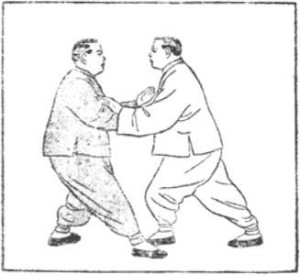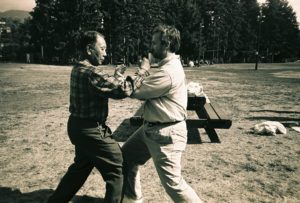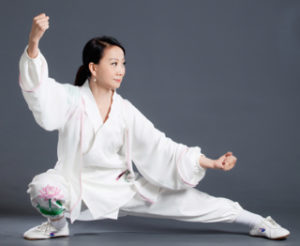Slanted FlyingJournal of Tai Chi Chuan
Training
Taijiquan’s Tui Shou (Push-hands) and Fighting from the Middle Range
Most Chinese martial arts, including Taijiquan, tend to avoid going to the ground. This is due to the vulnerability, of someone engaged with someone else on the ground, to attacks from other people standing above the wrestling pair. This is not a serious concern one-on-one, but outside of controlled competitions, where others may decide to get involved, going to the ground can be very dangerous. There is a literal reason behind the phrase ”kick them while they’re down.”
Taijiquan tries to establish an advantage by gaining control of the opponent when they come close enough to touch. It then uses this contact defensively by disrupting or controlling the opponent, preventing them from disengaging to recover and be able to launch new striking attacks, or against grapplers by preventing them from closing enough to apply their techniques. Simultaneously, Taijiquan uses this control to set up openings for offensive attacks against the opponent.
Once an attacker tries to strike (or to move in to grapple), it is to our advantage to “trap” them in this middle range and not allow them to move away (disengage) after the strike attempt, nor to close within grappling range. This is typically not practiced in push-hands since both participants are usually focused on training the middle range rather than escaping into long range, or closing to short range.
 Taijiquan tends to stay in middle range rather than retreating out of range of a strike, and to follow an opponent who attempts to get away. When an opponent attempts to strike, Taijiquan push-hands teaches how to control the energy of the opponent such that they feel that they cannot land their strike, yet when they try to disengage, they feel that they cannot escape.
Taijiquan tends to stay in middle range rather than retreating out of range of a strike, and to follow an opponent who attempts to get away. When an opponent attempts to strike, Taijiquan push-hands teaches how to control the energy of the opponent such that they feel that they cannot land their strike, yet when they try to disengage, they feel that they cannot escape.
I suspect that some practitioners question the usefulness of push-hands because its primary focus is defensive, and as a setup for offensive counterattacks, but does not generally include much practice of finishing techniques. Using push-hands to train the middle range provides skills to maintain one’s stability under pressure while sensing the vulnerabilities of others that remain in contact with you, but the follow-up attacks are often not taught in this format.
For those just looking for fun, or to improve their ability to maintain their balance when challenged (either in physical confrontations, or when inadvertently jostled in a crowd) or as one ages to prevent falls, or to better understand other principles of this art, the typical push-hands training, which usually begins from already established contact, is probably sufficient. However, if one wants to use Taijiquan martially, many practitioners would need to supplement their regular from-contact push-hands training with “bridging” training.
Bridging is the skill of going from non-contact to contact in the middle range where push-hands skills can be used. As atypical as training the middle range is, it is also difficult to keep the interaction in this middle range although, if one has the appropriate skill, the control in this middle range can be within seconds of contact (ideally, the control starts the instant contact is made).
We want our bridging to “trap” our opponent in the middle range, and to prevent them from returning to long, or non-contact, range before we can apply our counterattack. Likewise, we try to apply our counterattack before grappling opponents can enter into close range. Ideally, the opponent should feel uncomfortable either grappling or striking, if we successfully control them in this middle range, unless the opponent practices an art that also includes middle range training.
Most free play push-hands training, as well as tournament competitions, involves both participants trying to stay in the middle range until one can off-balance or otherwise control the other enough to move them against their will. This typically results in one participant being pulled or pushed a short distance away. Without a finishing move being applied, this is rather unimpressive martially. But to train or test one’s ability in the middle range, people need to stay in the middle range.
If used purely defensively to keep yourself safe, while also avoiding harm to your opponent, maintaining sustained control in the middle range is desirable. Used martially, the middle range is typically only maintained long enough to create an opportunity to attack, typically using a technique more damaging than a slight off-balancing push or pull, but that is set up by the off-balancing of the opponent. The instability of the opponent also serves a defensive function since it is difficult for them to execute an effective attack when off-balance.














Great review ! I shared in my page. Regarding striking, however, It is my opinion that tai chi may not be suitable to sport combat, but perhaps in real situation a blow from close range to a vulneravle area when the oponent is at mercy could do the job. Anyway, it is good to develop other skills.In my case I’ve learned as a part of the programme in a Kung Fu school. Recommend that.